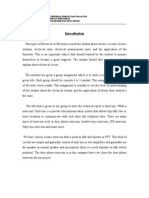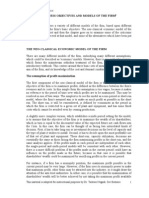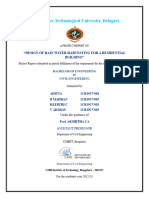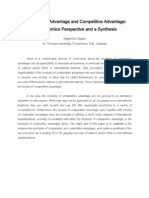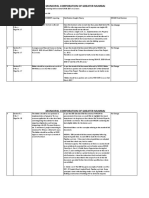Data and Database Administration
Data and Database Administration
Uploaded by
Trần Nguyên HươngCopyright:
Available Formats
Data and Database Administration
Data and Database Administration
Uploaded by
Trần Nguyên HươngCopyright
Available Formats
Share this document
Did you find this document useful?
Is this content inappropriate?
Copyright:
Available Formats
Data and Database Administration
Data and Database Administration
Uploaded by
Trần Nguyên HươngCopyright:
Available Formats
DATA AND DATABASE ADMINISTRATION
CISB514 Advanced Database
LEARNING OUTCOMES
At the end of this chapter, you should be able to:
Define terms related to data & dbase administration List functions and roles of data/database administration Describe role of data dictionaries and information repositories
Data and Database Administration
CISB514 Advanced Database
TRADITIONAL ADMINISTRATION DEFINITIONS
Data Administration: A high-level function that is responsible for the overall management of data resources in an organization, including maintaining corporate-wide definitions and standards Database Administration: A technical function that is responsible for physical database design and for dealing with technical issues such as security enforcement, database performance, and backup and recovery
Data and Database Administration
CISB514 Advanced Database
TRADITIONAL DATA ADMINISTRATION FUNCTIONS
Data policies, procedures, standards
Data Policies: statements that make explicit the goals of DA Data procedure: written outlines of actions to be taken to perform certain activity Data Standard: explicit conventions and behaviors that are to be followed and that can be used to help evaluate dbase quality
Planning Data conflict (ownership) resolution Managing the information repository Internal marketing of DA concepts
Data and Database Administration
CISB514 Advanced Database
DATA POLICIES, PROCEDURES, STANDARDS
1.
2.
3. 4.
5.
6.
All users must have passwords Password must be changed every 6 months Password must have minimum of 7 characters Password must have maximum of 12 characters Password must be combination of alphabet and numbers I/C number, names, birth date cannot be used as passwords.
Data and Database Administration
CISB514 Advanced Database
DATA POLICIES, PROCEDURES, STANDARDS
1.
To create password:
i.
ii.
iii.
iv.
v.
End user send request to DBA DBA approves and forward it to computer operator Computer operator creates account, assign temporary password and end it to the user. A copy of the account information is sent to the DBA User changes the temporary password.
Data and Database Administration
CISB514 Advanced Database
TRADITIONAL DATABASE ADMINISTRATION FUNCTIONS
Selection of DBMS and software tools Installing/upgrading DBMS Tuning database performance Improving query processing performance Managing data security, privacy, and integrity Data backup and recovery
Data and Database Administration
CISB514 Advanced Database
FUNCTIONS OF DA & DBA
DATABASE PLANNING Develop corporate database strategy/policies Develop enterprise model (information architecture) Develop cost/benefit models
Design database environment/select technologies
Develop and market data administration plan DATABASE ANALYSIS Define and model data requirements (conceptual) Define and model business rules Define operational requirements
Resolve requirements conflicts
Maintain corporate data dictionary/repository
Data and Database Administration
CISB514 Advanced Database
FUNCTIONS OF DA & DBA
DATABASE DESIGN Perform logical database design
Design external model (sub schemas)
Design internal (physical) models Design integrity controls DATABASE IMPLEMENTATION Specify database access policies Establish security controls Install DBMS Supervise database loading Specify test procedures
Develop application programming standards
Establish procedures for backup and recovery Conduct user training
Data and Database Administration
CISB514 Advanced Database
FUNCTIONS OF DA & DBA
OPERATIONS AND MAINTENANCE Backup and recover databases Upgrade DBMS Monitor database performance Tune and reorganize databases Resolve access conflict Tune and rewrite queries Enforce standards and procedures Support users GROWTH AND CHANGE Implement change-control procedure Plan growth and change Evaluate new technology
Data and Database Administration
CISB514 Advanced Database
EVOLVING APPROACHES TO DATA ADMINISTRATION
Blend data and database administration into one role Fast-track developmentmonitoring development process:
Database planning: improve selection of technology Database analysis: work on physical design in parallel with development of the logical & physical models Database design: prioritize application by volume, importance & complexity Database implementation Database maintenance
Data and Database Administration
CISB514 Advanced Database
EVOLVING APPROACHES TO DATA ADMINISTRATION
New DBA Roles
Procedural DBAsmanaging quality of triggers and stored procedures eDBAmanaging Internet-enabled database applications PDA DBAdata synchronization and personal database management Data warehouse administration
Data and Database Administration
CISB514 Advanced Database
DATA WAREHOUSE ADMINISTRATION
New role, coming with the growth in data warehouses Similar to DA/DBA roles Emphasis on integration and coordination of metadata/data across many data sources Specific roles:
Support DSS applications Manage data warehouse growth Establish service level agreements regarding data warehouses and data marts
Data and Database Administration
CISB514 Advanced Database
OPEN SOURCE DBMSS
DEFINITION:
Free DBMS source code software that provides the core functionality of an SQL-compliant DBMS
An alternative to proprietary packages such as Oracle, Microsoft SQL Server, or Microsoft Access
mySQL is an example of an open-source DBMS
Advantages:
Less expensive than proprietary packages Source code available, for modification Have different version (simple to complex, free to some cost(additional features) No additional cost for copies or licensing
Data and Database Administration
CISB514 Advanced Database
OPEN SOURCE DBMSS
Disadvantages:
Absence
of complete documentation Ambiguous licensing concerns Not as feature-rich as proprietary DBMSs Vendors may not have certification programs
Data and Database Administration
CISB514 Advanced Database
OPEN SOURCE DBMSS
Consider
these factors when choosing an open source DBMS:
Features Support Ease-of-use Stability Speed
Training
Licensing
Data and Database Administration
CISB514 Advanced Database
DATA MODELING RESPONSIBILITIES
Data and Database Administration
17
END OF CHAPTER
INFORMATION IN THIS SLIDES WERE TAKEN FROM MODERN DATABASE MANAGEMENT SYSTEM, NINTH EDITION BY JEFFREY A.HOFFER, MARY B.PRESCOTT & HEIKKI TOPI.
CISB514 Advanced Database
ROUTINES AND TRIGGERS
Routines
Program
modules that execute on demand Functionsroutines that return values and take input parameters Proceduresroutines that do not return values and can take input or output parameters
Triggers
Routines
that execute in response to a database event (INSERT, UPDATE, or DELETE)
Data and Database Administration
CISB514 Advanced Database
ROUTINES AND TRIGGERS
Data and Database Administration
CISB514 Advanced Database
STORED PROCEDURE
CREATE PROCEDURE sp_GetInventory @location varchar(10) AS SELECT Product, Quantity FROM Inventory WHERE Warehouse = @location EXECUTE sp_GetInventory Kajang'
Data and Database Administration
21
CISB514 Advanced Database
TRIGGERS
CREATE TRIGGER STANDARD_PRICE_UPDATE AFTER UPDATE OF STANDARD_PRICE ON PRODUCT_T FOR EACH ROW INSERT INTO PRICE_UPDATES_T VALUES (PRODUCT_DESCRIPTION, DATE, STANDARD_PRICE);
Data and Database Administration
You might also like
- Electrical Machines: S.K. Kataria & SonsDocument22 pagesElectrical Machines: S.K. Kataria & SonsAli Sabah100% (1)
- Patent of NativityDocument2 pagesPatent of Nativityjoe100% (6)
- FAI Clubhouses & Changing Rooms - Notes On Planning, Design & Layout 2010Document40 pagesFAI Clubhouses & Changing Rooms - Notes On Planning, Design & Layout 2010glenarmNo ratings yet
- IntercomDocument17 pagesIntercomRavi Sankar67% (3)
- BOQ Water ReticulationDocument8 pagesBOQ Water Reticulationnani.makhalema83100% (1)
- Paving BlocksDocument50 pagesPaving BlocksHansika JayathilakaNo ratings yet
- Screeds, Tiles - Stone Adhesive & GroutsDocument24 pagesScreeds, Tiles - Stone Adhesive & GroutsparulhariyaNo ratings yet
- Bridge Prelim DesignDocument146 pagesBridge Prelim DesignSimonNo ratings yet
- Attachment 3 - Drawing Title BlockDocument1 pageAttachment 3 - Drawing Title BlockLai HuynhNo ratings yet
- Demand Analysis and ForecastingDocument41 pagesDemand Analysis and ForecastingjleungcmNo ratings yet
- Theory of The Firm 2003Document23 pagesTheory of The Firm 2003vikrant89100% (1)
- Accounting Rate of ReturnDocument1 pageAccounting Rate of ReturnNeeraj Dharia100% (1)
- ME - Business Objectives and Models of The Firm - 10Document26 pagesME - Business Objectives and Models of The Firm - 10semerederibe100% (1)
- V. Five Generic Competitive Strategies Cost Efficient Management and Revamping of The Value ChainDocument5 pagesV. Five Generic Competitive Strategies Cost Efficient Management and Revamping of The Value Chaingwyneth aquino100% (1)
- Low Volume Sealed Roads (LVSR)Document281 pagesLow Volume Sealed Roads (LVSR)jonathan chandaNo ratings yet
- Sanlu Group2Document17 pagesSanlu Group2Corey ChanNo ratings yet
- Constitution of Zimbabwe, 2013Document103 pagesConstitution of Zimbabwe, 2013toga22No ratings yet
- Design ReportDocument71 pagesDesign ReportSumaidha ParmarNo ratings yet
- Ethics in Finance: What Dose Finance MeansDocument5 pagesEthics in Finance: What Dose Finance Meanssinghashish5444No ratings yet
- 3 Ch3 Managerial Theories Part IDocument23 pages3 Ch3 Managerial Theories Part Ilolobeboy100% (1)
- Flowing Artesian Wells PDFDocument10 pagesFlowing Artesian Wells PDFJaykumar PatelNo ratings yet
- Methodology For Calculating The Energy Performance of Buildings - Riigi TeatajaDocument3 pagesMethodology For Calculating The Energy Performance of Buildings - Riigi TeatajaWisnu Kertaningnagoro100% (1)
- SOFTWARE DEVELOPMENT Quiz 2Document22 pagesSOFTWARE DEVELOPMENT Quiz 2Abdul QadeerNo ratings yet
- A New System Design and Analysis of A Solar Bio-Digester UnitDocument19 pagesA New System Design and Analysis of A Solar Bio-Digester UnitJuan SierraNo ratings yet
- Managerial Economic Demand FunctionDocument20 pagesManagerial Economic Demand FunctionPsy Vivianne86% (7)
- Boom Gate DrawingDocument1 pageBoom Gate DrawingMohd KamalNo ratings yet
- Mechanical MeasureDocument15 pagesMechanical MeasureNabanita AdhikariNo ratings yet
- Gropu 10 Assignment 1Document12 pagesGropu 10 Assignment 1Brian Zungu100% (1)
- Access Road & Gravel Production RateDocument9 pagesAccess Road & Gravel Production RateAshenafi Girma NegashNo ratings yet
- Gully Excursion ReportDocument9 pagesGully Excursion ReportYhemmy Lhawal JummyNo ratings yet
- GEOMATIC - Areas & VolumeDocument32 pagesGEOMATIC - Areas & VolumeAK47100% (2)
- Software Testing MethodologiesDocument10 pagesSoftware Testing MethodologiesBogdanNo ratings yet
- Project Report Format - 22-05-23 (Final) AnkushDocument64 pagesProject Report Format - 22-05-23 (Final) AnkushgankushgawaiNo ratings yet
- Baumols TheoryDocument35 pagesBaumols TheoryAman Singh Rajput100% (1)
- Economies & Diseconomies of Scale & ScopeDocument51 pagesEconomies & Diseconomies of Scale & ScopeAshwin Prasad0% (1)
- Effort Distribution On Waterfall and AgileDocument12 pagesEffort Distribution On Waterfall and Agileanandapramanik100% (2)
- Driving Forces Supply Chain ManagementDocument8 pagesDriving Forces Supply Chain ManagementMuhammad Qasim Malik100% (1)
- Sanlu Case StudyDocument10 pagesSanlu Case StudyJasvin BhasinNo ratings yet
- A. Preliminaries - General ConditionsDocument31 pagesA. Preliminaries - General Conditions2C Nur Izzati Binti RamleeNo ratings yet
- Hydrologic PrinciplesDocument93 pagesHydrologic PrinciplesJaden MoniezNo ratings yet
- Biogas TecDocument131 pagesBiogas TecHabimana Fabien100% (1)
- Road Safety and Traffic Management in GhanaDocument35 pagesRoad Safety and Traffic Management in GhanaBernard OwusuNo ratings yet
- Collapsible Soil - Part IDocument21 pagesCollapsible Soil - Part Iamoddather100% (1)
- Physics Form OneDocument103 pagesPhysics Form OneBoniphace50% (2)
- Baumol ModelDocument25 pagesBaumol ModelHarish HarishNo ratings yet
- 10 CH 17 SchedulingDocument48 pages10 CH 17 SchedulingDarsh MenonNo ratings yet
- Leed Rating SiystemDocument69 pagesLeed Rating SiystemArun Krishnan 122No ratings yet
- 2022 Building Energy Efficiency StandardsDocument533 pages2022 Building Energy Efficiency Standardshellaspam888No ratings yet
- FINALDocument41 pagesFINALdeepikaNo ratings yet
- Capacity Development and Water EfficiencyDocument184 pagesCapacity Development and Water Efficiencyscorpio1878100% (1)
- ECBC As A Tool For Energy EfficiencyDocument10 pagesECBC As A Tool For Energy EfficiencyMathimuvanNo ratings yet
- ARTIGO - FUNDAMENTOS - A Brief History of Project Management (Duncan Haughey)Document5 pagesARTIGO - FUNDAMENTOS - A Brief History of Project Management (Duncan Haughey)marcusforteNo ratings yet
- Organizational Structure and Design: Stephen P. Robbins Mary CoulterDocument41 pagesOrganizational Structure and Design: Stephen P. Robbins Mary CoulterAmbreen ZainebNo ratings yet
- Nature and Evolution of Corporate GovernanceDocument19 pagesNature and Evolution of Corporate GovernanceRashmi SinghNo ratings yet
- K. Subramanya - Engineering Hy-Hill Education (India) (2009) 12 PDFDocument1 pageK. Subramanya - Engineering Hy-Hill Education (India) (2009) 12 PDFcivilengeeNo ratings yet
- Comparative Vs Competitive AdvantageDocument19 pagesComparative Vs Competitive AdvantageSuntari CakSoenNo ratings yet
- Planning, Analyzing and Designing of Collectrate Building Using STAAD ProDocument10 pagesPlanning, Analyzing and Designing of Collectrate Building Using STAAD ProInternational Journal of Application or Innovation in Engineering & ManagementNo ratings yet
- MG 6863 Engg Economics UNIT 1-5Document166 pagesMG 6863 Engg Economics UNIT 1-5KaviArasu100% (1)
- Design Calculation Sheet: A-Water DemandDocument1 pageDesign Calculation Sheet: A-Water DemandrahulrampNo ratings yet
- DB AdministrationDocument26 pagesDB AdministrationEula Grace Tejada RamosNo ratings yet
- Immediate download (eBook PDF) Database Administration The Complete Guide to DBA Practices and Procedures (2nd Edition) ebooks 2024Document45 pagesImmediate download (eBook PDF) Database Administration The Complete Guide to DBA Practices and Procedures (2nd Edition) ebooks 2024zreballica36100% (9)
- Chapter 1Document45 pagesChapter 1esammagdy789No ratings yet
- Database AdministratorDocument34 pagesDatabase AdministratorTech_MXNo ratings yet
- Curs Symfony - EnglezaDocument295 pagesCurs Symfony - EnglezalucianluciNo ratings yet
- Re Suelto SirDocument2 pagesRe Suelto SirWILFREDO ROMAN PAUCARNo ratings yet
- BWSI 2024-2025 Build A CubeSat Challenge FAQsDocument6 pagesBWSI 2024-2025 Build A CubeSat Challenge FAQsSamaksh BharagavNo ratings yet
- Office Snapshot Q1 2016: MarketbeatDocument3 pagesOffice Snapshot Q1 2016: Marketbeatsai7891No ratings yet
- UPSC Mains Blank Answer SheetsDocument11 pagesUPSC Mains Blank Answer SheetsRahul Yadav67% (3)
- Alhassan ElijahDocument5 pagesAlhassan ElijahAbdullahNo ratings yet
- Chapter 2 Review QuestionsDocument10 pagesChapter 2 Review Questionsnilkar08No ratings yet
- Management Concepts Notes by - DR - Neha Mathur Ma AmDocument6 pagesManagement Concepts Notes by - DR - Neha Mathur Ma AmRohan RalliNo ratings yet
- Types and Applications of MaterialsDocument53 pagesTypes and Applications of MaterialsGeno Martinez100% (1)
- User Guide: R5010W/R5010B R5510W/R5510B/R5510SDocument17 pagesUser Guide: R5010W/R5010B R5510W/R5510B/R5510SEric munyweNo ratings yet
- 3TEMPORARY STRUCTURE Fall Protection Working at HeightsDocument85 pages3TEMPORARY STRUCTURE Fall Protection Working at HeightsEunice GayetaNo ratings yet
- 2024-01-25 Calvert County TimesDocument40 pages2024-01-25 Calvert County TimesSouthern Maryland OnlineNo ratings yet
- MCGM - CVS - Queries Final With SD SignDocument10 pagesMCGM - CVS - Queries Final With SD SignMrigank AggarwalNo ratings yet
- Chapter Four - Internal Loss DataDocument26 pagesChapter Four - Internal Loss DataaafnanNo ratings yet
- K-ROSET Demo Operating Manual - ENDocument9 pagesK-ROSET Demo Operating Manual - ENcabecavilNo ratings yet
- Residential StatusDocument7 pagesResidential StatusquickcabitesNo ratings yet
- Calibration Methods of Hull-White ModelDocument43 pagesCalibration Methods of Hull-White ModelJerry MaoNo ratings yet
- How To Do A Literature Review Helen AveyardDocument5 pagesHow To Do A Literature Review Helen Aveyardc5pnw26s100% (1)
- 320C Excavator PartsDocument783 pages320C Excavator PartsRay100% (5)
- Dye Penetrant Inspection ProcedureDocument7 pagesDye Penetrant Inspection ProcedureNDTInstructor100% (1)
- Johnny C. Bennett Practical Computer Analysis Switch Mode Power Supply WWW - IranSwitching.ir PDFDocument261 pagesJohnny C. Bennett Practical Computer Analysis Switch Mode Power Supply WWW - IranSwitching.ir PDFAlvaro Javier Baños RiveraNo ratings yet
- Senior Project PresentationDocument11 pagesSenior Project Presentationapi-542121636No ratings yet
- Apalisok vs. RadioDocument2 pagesApalisok vs. RadioJas Mine100% (1)
- Engineering GeologyDocument16 pagesEngineering GeologySubash LamichhaneNo ratings yet
- Parent Guide & Instructions: Get Started and Download Your Included Learning AppDocument2 pagesParent Guide & Instructions: Get Started and Download Your Included Learning Approcksteady nickelNo ratings yet
- Escorts F15 Pick and Carry Crane PDFDocument2 pagesEscorts F15 Pick and Carry Crane PDFVenugopal Sri33% (3)
- Product Guide o e w46fDocument208 pagesProduct Guide o e w46fXian-Jhay AboyNo ratings yet



